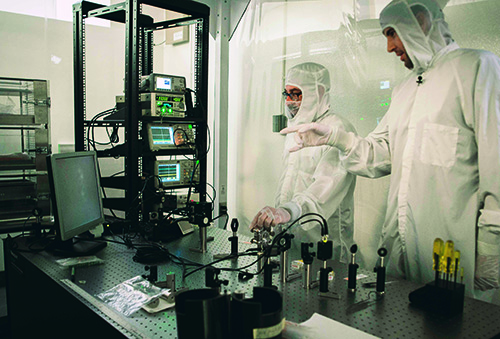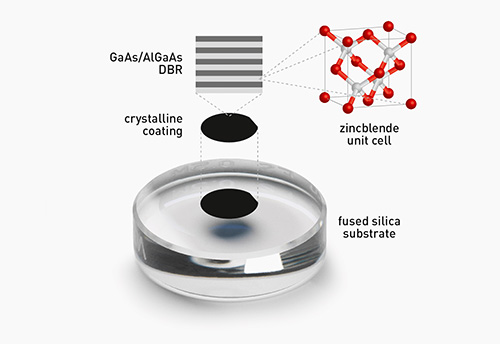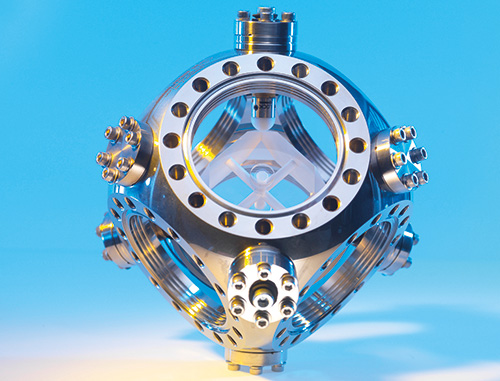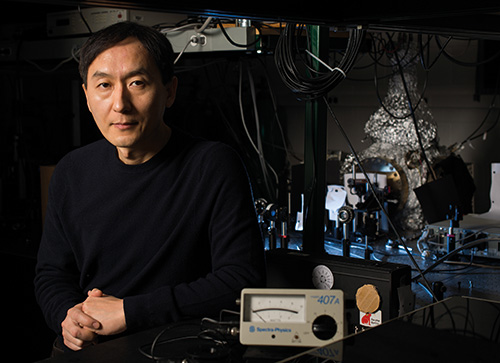As the use of space-based instruments such as telescopes, satellites and probes increases, a number of companies and research organisations are busy developing innovative coatings for onboard optical components. So, what are some of the most recent advances in the development and application of optical coatings for space-based devices? And, could advances made in the space sector eventually trickle down to other optical coating markets?
Unlike the materials used on Earth, optical coatings for space-based applications need to be extremely stable and durable – largely because maintenance and exchange as a result of wear and tear is not easily possible. These requirements mean that space-based optics must be of the highest quality, and often be tailor-made for specific applications. According to Helmut Kessler, managing director at Manx Precision Optics (MPO), this relentless focus on quality often results in space-related products that are at the forefront of the currently feasible specifications.
‘Space-based applications help to push forward the boundaries of technology, and therefore make a company more innovative,’ he said.
One such company is Colorado-based outfit N-Science, which has created the innovative Deep Space Black (DSB) material used to coat a wide variety of instruments, including the Viscam device on the NASA Raven craft. As Dan Scheld, president at N-Science, explained, DSB is essentially the product of a ‘wet chemistry process,’ which results in a highly dentritic ‘space qualified’ surface typical of many optical materials used in space. In tandem with overall optical performance, Scheld believes surface properties such as the ability to provide uniformity over large areas, as well as the ability to deliver this uniformity on complex geometries including internal features, are also ‘critical’ features of space-based coatings. Another important consideration is the overall mechanical stability.
‘The surface must be robust enough to withstand launch operations and in-orbit operations. In LEO [low Earth orbit] environments the surfaces are exposed to electron radiation and atomic oxygen,’ said Scheld.
Alexander Muhr, senior applications engineer at California, US-based Element Six, agreed that the durability of optics for space-based devices is ‘absolutely critical’ and noted that it can be extremely difficult and expensive – sometimes impossible – to replace components that fail in space.
In an effort to face up to these challenges, the company has developed a novel optical polycrystalline diamond material that Muhr says is ‘incredibly robust mechanically, thermally, and in terms of laser damage threshold’.
‘Optics made from this material will be able to last longer in the field and survive harsh environments that would cause other solutions to fail. This means less costly repairs and possibly new applications in harsh environments,’ he said. ‘Diamond also has the broadest electro-magnetic transmission spectrum, from UV to microwave, of any window material. This makes diamond great for spectroscopic and hyperspectral imaging applications,’ he added.
Shelf life
Another company very active in this field is UK firm Artemis Optical, which manufactures two types of coatings for space-based applications – high performance mirrors and narrow band pass filter coatings. According to sales director Jamie Pindard, the company has recently completed a contract for a UK space firm to create narrow band pass filter coatings capable of operating at the cryogenic temperatures commonly experienced in space – meaning that the team had to optimise the coatings’ thermal stability ‘whilst ensuring the spectral performance was not affected.’ Artemis filters were also recently used on an electro-optical payload that formed part of a satellite imaging system used to monitor crop growth and sea levels for the host country. The filters work by allowing specific wavelengths of light to transmit through the optic to allow the system to ‘see’ the colour in question.
‘The coating also has to block out other energy in the UV, visible and infrared to ensure that there is no distortion of discolouration in what the system can see. In this instance, our filter suite had to transmit green, red, yellow, blue and near-infrared,’ Pindard explained.

The CMS team working in a clean room
‘As coating is itself a niche area of technology, it is not unusual for potential customers to partner with us at the early stages of a requirement to utilise our expertise in this area. We often develop the coating specification for the customers to meet their system requirements,’ he added.
Pindard agreed that the key challenge faced in developing a coating for space is the need to ensure performance over time as, unlike land-based systems, the equipment is not easily replaced. In recognition of this fact, he reveals that Artemis staff often work with customers to determine the exact level of accelerated shelf life or stress testing deemed necessary to guarantee confidence of functionality after launch.
‘We believe that being open to complete several iterations of a product and allowing for these to be tested by the customer in some way is key to this approach to working. At a practical and financial level, this means having an NRE [non-recurring engineering] model which is not prohibitive and flexible, both commercially and technically, to a change of requirements,’ he said.
Although many companies produce optical coatings with space-based applications specifically in mind, others manufacture materials that are in practice no different from those created for earth-based uses. One such company is Edmund Optics, which is currently working with NASA on a set of specifications for an imaging lens to be used for various inspection activities on the International Space Station (ISS). According to Joel Bagwell, director of engineering and manufacturing technology at the company, the fact that the lens will not be exposed to the vacuum of outer space means that there have not yet been any ‘out of the norm’ requests for coatings specifically adapted to the conditions seen in Earth orbit.
‘Much of what we sell that goes into outer space is still contained in some sort of environment control structure. As such, we have not really developed anything recently specifically for space,’ Bagwell commented.
‘However, once you go very broadband, or want to view say, solar flares, the design space gets very dicey. Material selection, deposition parameters, and heat build-up all become rigid design restrictions that must be accounted for,’ he added.

A schematic of the CMS crystalline mirror coatings
Crystalline Coatings
Elsewhere, Austria and US-based company Crystalline Mirror Solutions (CMS) manufactures high-performance optical sub-assemblies, such as low-noise reflectors for precision interferometry, using a novel crystalline coating technique. In terms of space-based systems, the firm also supplies end mirrors for ultra-stable optical reference cavities used in the construction of narrow-linewidth (sub-Hz) laser systems. As co-founder Garrett Cole explained, such high-end laser systems are ‘key elements’ in precision optical metrology – enabling record performance in atomic clocks, stable microwave generation, and laser ranging.
Cole described CMS’s substrate-transferred crystalline coating technique as a ‘radically new approach’ for realising high-performance optical interference coatings, allowing the integration of single-crystal multi-layers with a wide variety of relevant optical substrate materials possessing arbitrary, including curved, geometries.
As part of a consortium led by Airbus and funded by the European Space Agency (ESA), the company is currently working on the first implementation of crystalline coatings – or semiconductor super-mirrors, as it calls the final optical components – in a space-relevant application. As part of this project, the CMS team will coat super-polished fused silica substrates with an ultrahigh-reflectivity multilayer stack. A pair of these coated optics will then be assembled into an optical cavity, which will ultimately be employed as an optical reference for a cavity-stabilised laser system. According to Cole, the ultimate goal of this effort is to supply a robust and high-performance optical reference cavity for the construction of a near-infrared ‘optical local oscillator’ – or OLO – with millihertz linewidth while working within the stringent packaging constraints of a satellite platform.
‘[Another] of the major focuses of this effort is to further enhance the technological readiness level of our coatings and pursue space qualification of the final optics. This includes rigorous tests of the mechanical stability, radiation hardness, environmental stability and lifetime of our semiconductor super-mirrors,’ he said.

An optical stabilising reference cavity within a vacuum chamber
Trickle down
Looking ahead, MPO’s Kessler believes that the development of new optical coating technology will continue at a rapid pace – and predicts it is ‘almost a given’ that technologies developed for space and similar applications will eventually trickle down to other markets. In fact, according to Pindard, Artemis Optical is already making similar products for commercial and industrial applications, noting that band-pass filters can be used for observing and monitoring ‘any number of colours, gases or moisture’.
‘Our products are currently in use alongside industrial and food production lines to ensure that levels of particular fats and chemicals are within the acceptable limits for product acceptance,’ Pindard said.
‘Generally speaking, the tolerances of the manufacture of parts required for the space sector are more stringent than those in commercial applications. Being able to meet those requirements has pushed the envelope of our process capabilities and places us in a strong position to be able to offer a higher performing coating to these other markets. We think there is a particular application within health care, specifically the monitoring of a patient’s breath whilst under anaesthetic,’ he added.
Although CMS’s current core customers are academic and scientific end users at universities and national laboratories, Cole also reported an ‘uptick in demand’ from industrial customers in similar market areas such as optical metrology for time and frequency standards, laser ranging, and microwave source development. The company is also actively expanding the ‘application space of its novel coatings by targeting additional industrial sectors such as trace gas detection via optical ringdown and high-power laser machining systems.
‘Our goal is that the space qualification of our low-noise mid-IR optics will enable us to also pursue space-relevant applications for our mid-IR and high thermal conductivity, or high power, optics,’ he said. ‘Moreover, the lessons learned in the development of optimised manufacturing techniques as required for constructing space-qualified optics will certainly find their way into terrestrial products,’ he added.
Edmund Optics’ Bagwell pointed out that market segments other than space are currently driving the coatings work at Edmund Optics – particularly in fields such as high laser fluence applications like materials processing and areas demanding the processing of smaller runs of optics more quickly.
‘We definitely see advances in these two areas propagating elsewhere, potentially into the space arena. For instance, when we develop a coating for a 355nm YAG harmonic in the UV, such a coating is immediately applicable to the UV spectrum coming from the sun and other stars for either analysis or protection from solarisation. So tricks we pick up for a high volume arena like laser optics, will have utility in other markets,’ he commented.
Towards a coating-free future?
While many organisations around the world devote their time to the development of next-generation optical coatings, some are now focusing their attention on a future that might do away with the need for coatings altogether. One such organisation is the University of Rochester, where a team of scientists has created an interesting new technique that visualises ‘the complete evolution of micro- and nanoscale structural formation on a material’s surface’ – which could eventually pave the way for future ‘coating-free’ space telescopes.

Chunlei Guo, professor of optics and physics at the University of Rochester
Over the past few years, a research team led by Chunlei Guo, professor of optics and physics at the university, has developed a range of laser processing technologies capable of equipping regular metal surfaces with special properties, such as the ability to attract or repel water or absorb a large amount of light – all without any type of chemical coating. These special surface effects come from a range tiny micro- and nano-structures that the team create on the metal surfaces, as Guo explained. ‘To understand how these tiny structures were formed, we set out to develop an imaging technique that allows us to resolve the complete evolution of micro- and nanoscale structural formation, both during and after the application of a laser pulse,’ he said.
To resolve the surface evolution, the team begins by using a stronger laser pulse to induce the surface morphological change, followed by another pulse that acts like a camera flash to illuminate the changing dynamics.
This imaging pulse occurs at a later time – somewhere between one quadrillionth of a second to a few hundred billionths of a second later – providing the researchers with a ‘movie frame’ at each time delay. By piecing all these frames together, Guo said he and his team can collect a complete movie of what happens on the metal surface and how these structures are formed in real time. ‘Currently, space-based instruments mostly focus on spatial, rather than temporal, resolution. But I think the temporal capacity can come into play in the future. At that point, the basic principle of our technique will apply,’ he said.
‘We have plans for further commercial developments for our functionalised surfaces. Moving forward, making our process more efficient and controllable is very important and the imaging technique will be crucial in these developments,’ he added.


